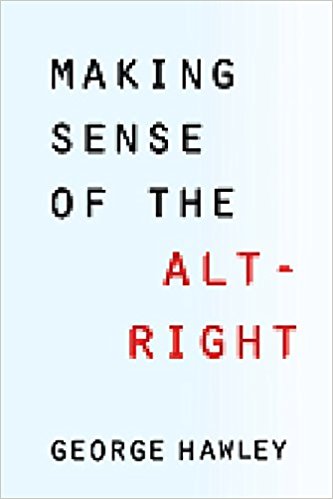[amazon_link asins=’023118512X’ template=’ProductAd’ store=’beerpoli-21′ marketplace=’ES’ link_id=’192ab7d8-b73c-11e7-ad1f-ebf4b75ea858′]

During the 2016 election, a new term entered the American political lexicon: the «alt-right,» short for «alternative right.» Despite the innocuous name, the alt-right is a white-nationalist movement. Yet it differs from earlier racist groups: it is youthful and tech-savvy, obsessed with provocation and trolling, amorphous, predominantly online, and mostly anonymous.
And it was energized by Donald Trump’s presidential campaign. In Making Sense of the Alt-Right, George Hawley provides an accessible introduction to the alt-right, giving vital perspective on the emergence of a group whose overt racism has confounded expectations for a more tolerant America. Hawley explains the movement’s origins, evolution, methods, and its core belief in white identity politics. The book explores how the alt-right differs from traditional white nationalism, libertarianism, and other online illiberal ideologies such as neoreaction, as well as from mainstream Republicans and even Donald Trump and Steve Bannon.
The alt-right’s use of offensive humor and its trolling-driven approach, based in animosity to so-called political correctness, can make it difficult to determine true motivations. Yet through exclusive interviews and a careful study of the alt-right’s influential texts, Hawley is able to paint a full picture of a movement that not only disagrees with liberalism but fundamentally rejects most of the tenets of American conservatism. Hawley points to the alt-right’s growing influence and makes a case for coming to a precise understanding of its beliefs without sensationalism or downplaying the movement’s radicalism.
Share
Related Articles
Comportamiento electoral enero 8, 2020
Antisistema. Desigualdad económica y precariado político
JOSÉ FERNÁNDEZ-ALBERTOS ¿Cuáles son las causas del éxito de los nuevos partidos antisistema?…
Comportamiento electoral enero 4, 2020
El terratrèmol silenciós. Relleu generacional i transformació del comportament electoral a Catalunya
ORIOL BARTOMEUS La transformació del comportament electoral i dels sistemes polítics és una…
Comportamiento electoralInternacional enero 2, 2020
Dios salve a Texas. Viaje al futuro de Estados Unidos
LAWRENCE WRIGHT Las botas, las camionetas, las armas, la actitud… El estado de…

















